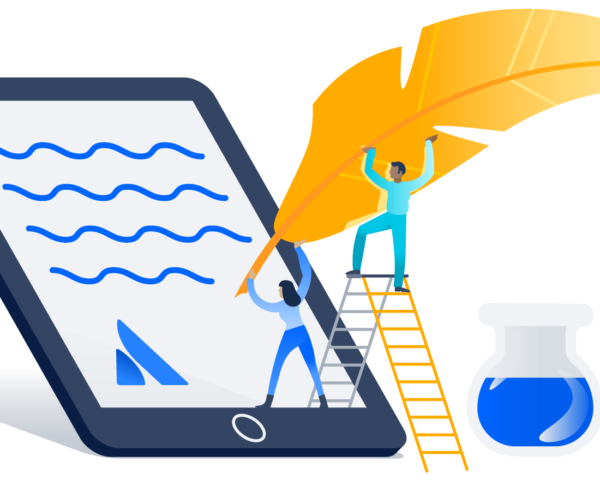How to create and maintain a single source of truth
Tips from a global team continuing to scale against the odds.
Whether you’re a small team shifting into growth mode or an enterprise in the midst of a massive expansion, implementing the right processes, practices, and platforms can make or break your success – but that’s easier said than done. It can be hard to know where to start, how to change habits, and how to maintain momentum. Companies who have effectively made and sustained changes in their culture and infrastructure, especially during times of rapid growth or adversity, are wells of wisdom we can all draw from for inspiration and best practices. Global brand and customer experience agency VMLY&R is a standout example.
When Heather Physioc joined VMLY&R in 2014, she was one of only two people on the Organic Search team, so there wasn’t an immediate need for standardizing tools or processes. As VMLY&R grew organically and through acquisition, Heather’s now-renamed Discoverability group (comprising the Organic Search, Paid Search, and Performance Content teams) went from a two-person powerhouse in Kansas City to a globally distributed team of 35.
Almost all work was done on site, across six North American offices – until early 2020. Amid the fast spread of COVID-19, VMLY&R transitioned all employees from offices to working from home in a matter of days. It was enough to intimidate even the most prepared, tech-savvy businesses. But because Heather and her team had already laid a strong foundation by building a communicative and connected culture, integrated teams, and a solid infrastructure, she says: “We were almost unfazed… It was like a no-brainer.” Amazingly, the Discoverability team is confident they can continue the rapid growth, improved efficiency and collaboration, and award-winning work they’ve achieved in recent years.
So, how did they do it? In a nutshell, by embracing a new team structure and going all in on a single source of truth. It didn’t happen overnight, but Heather learned valuable lessons along the way that contributed to her team’s success.
1. Decentralize authority and centralize information
As Heather prepared to grow her team, she seized the opportunity to shift the group’s traditional, hierarchical structure to a more connected approach. “Our work was very project-driven before, and my view on search is that it should be much more iterative and continuous,” she says. “So I set a clear objective in year one: convert from project to partnership.”
To reach this goal, Heather immersed herself in the world of organizational structures and found one that matched her vision: networked teams. “The concept of ‘networked teams’ is all about decentralizing operations and centralizing information with a single source of truth. I think of it as a happy medium between command-and-control, which is very prescriptive, and a completely open-ended, ‘everyone-for-themselves’ model. Everyone in the group has access to knowledge, tools, and resources at all times, but the way they’re brought to life for a project or challenge might be completely different.”
Over the course of a year, Heather shifted the Discoverability practice to a networked-team model, while hiring new people that shared the group’s core values: communication, collaboration, being a team player, accountability, and empathy. These values not only contributed to a stronger, more Open culture, but also laid the groundwork for success with the new structure.
With the right model and the right people in place, Heather then identified tools and processes that would help them be most effective. Since several VMLY&R teams were already using Atlassian products and Heather had some experience with the platform, she chose Confluence as the central repository for information and knowledge sharing.
To support the networked-team model, Heather set the expectation that each team member should “take the information [from Confluence], personalize it, and activate it in a different way for each client or situation.” In essence, Confluence is the toolbox, and each employee has the freedom to use whichever tools they want, however makes sense for the task at hand.
Throughout the transition to this new model (and still to this day), Heather coached her team, reinforced expectations, and worked hard to decentralize authority. Rather than the group looking to her for direction every day, she reminds them that she is more like the “connective tissue,” or facilitator that enables them to do what they do best. “Our goal has been to build the most connected brands with the most connected teams,” Heather says. “To do that, we had to create the infrastructure and documentation so we don’t waste time or lose institutional knowledge, then give everyone the freedom to think creatively and improve on it.”
Heather attributes the networked-team model to her group feeling more empowered, moving faster, and collaborating better than ever before – and it’s all led to calculable results. Discoverability has increased revenue by 15x and team size from one to 35 in the last five years. While they had lots of strong individual performers before, it was only when they embraced a new structure and single source of truth that they unlocked exponential growth as a team.
2. Create a single source of truth
A core tenet of networked teams, which enables their speed and scalability, is having a central knowledge base for easy storage and sharing.
Prior to going all in on Confluence, Discoverability had accumulated a collection of tools filled with scattered, outdated, and duplicate data. “Before, it was hard to get up to speed and completely overwhelming to find resources because we had so many tools,” Heather says. “Now, we treat Confluence like a knowledge base, our encyclopedia.” From team calendars and handbooks, to policies and meeting notes, to client documentation and business development materials, to simple details like contact information and birthdays, all important information is stored in Confluence, and everyone has access to it.
Other teams wanted to know Discoverability’s secret formula for success as they saw how the group was using Confluence to store institutional knowledge, collaborate on projects, quickly and easily find exactly what they needed, and scale to serve more clients. “I had people come to me and say,’Tell me how you did this on your team!’” Heather recalls. “And I’m like, ‘No problem. Here’s a link to our workspace in Confluence. Copy it, and run with it.’”
Today, all of VMLY&R North America has replicated Discoverability’s “secret sauce” – a shift that proved even more valuable when the company’s work arrangements changed rapidly. As the team has shifted from being 100 percent on-site to 100 percent working from home to a hybrid model, employees have used Confluence to stay connected, communicate, and collaborate – no matter where they are.
3. Then, diligently maintain that single source of truth
Like a pristinely organized closet, keeping a central knowledge base usable requires maintenance. As Heather explains, “If you don’t make [it] part of the culture and an expectation of the job, it quickly becomes outdated and goes underutilized.”
To ensure her team gets the most value possible out of Confluence, she set expectations and processes around usage and governance from the beginning. For example, when Heather decided to consolidate from multiple, disparate tools to Confluence, she instructed all Discoverability employees to discontinue their use of other tools, provided training on how to use Confluence, helped them move what they needed over to the new workspace, and deemed it the team’s sole knowledge base going forward.
Heather also defined clear roles, responsibilities, and triggers to support maintenance and accountability. Roundups of alerts and maintenance reminders are automatically sent each week. Plus, at the beginning of every monthly account strategy session, the Account Lead for that particular client knows it’s their responsibility to spend the first few minutes of the meeting guiding the team through updating client notes and internal documentation in Confluence.
Shared trust and maintenance expectations have served the team as they’ve expanded and become more distributed. Even when they aren’t together in person to maintain Confluence, they keep each other accountable. “It’s almost become part of our culture to say, ’Hey, we should update that.’” Heather describes. “I can trust that everyone owns it without me micromanaging.”
Whether a company is centrally located or dispersed, Heather says maintenance is a must: “You can spend money on the fanciest tools, but if you don’t have the commitment and consistency to roll it out and maintain it, you aren’t going to experience the maximum impact.”
4. Create and cross-train on processes
Knowing the “who, what, when, why, and how” for each task, and having easy ways to access and share that information, is critical for scaling efficiently and effectively.
In addition to using Confluence for documentation and collaboration, VMLY&R leverages Trello for project management and Jira Software for technical projects. Cross-training team members on these processes and tools has saved time, relieved stress, and made scaling seamless.
Heather shares an example: “We store new business and RFP pitch materials in Confluence so we don’t have to reinvent the wheel. Every time someone pitches a new client, whether that’s the person who usually takes on that role or not, they’ve been trained to go to Confluence so they can pull something off the shelf and show it quickly.” All team members are also trained on Trello, which Heather says “takes about 15 minutes tops to learn,” so they know how to use it whether it’s part of their everyday workflow or not.
With common knowledge about processes as well as solid systems, Discoverability has been able to move faster and collaborate more effectively to produce even better work. “It feels like our team of 35 is an army of 100,” Heather says. “[And with Confluence], everyone knows where to look, so you’re cutting a ton of wasted time spent asking questions about processes or hunting stuff down. It’s all right there. And the expectation is that we’re updating it and sharing our knowledge.”
The competitive advantage is real
Scaling a team from two to 35 or 35 to 3,500 is no easy feat, especially when it’s done under stressful conditions like VMLY&R (and many other companies) experienced in early 2020. But a few shifts in culture, expectations, and platforms can lead to huge payoffs.
Even before they went fully remote, VMLY&R was seeing the results of decentralizing teams while centralizing information with a single source of truth: exponential growth in revenue, team size, award-winning work, and more. While most companies would see performance, communication, and collaboration drop amid abrupt changes, Heather is seeing the opposite. “Confluence creates a little stability in a world that is very uncertain for us. It’s our trusty place to fall back on and our best way to stay connected. It frees up time and brain power, and now we have the ability to hold ourselves and each other accountable, even when we aren’t next to each other,” she says.
And all of this contributes to a competitive advantage. “It can be frustrating and time-consuming upfront,” Heather admits. “But you have to create that culture of openness, vulnerability, and feedback, and the expectation of iteration, evolution, and change…To quote my colleague, ‘As individual teams, we are experts. As an integrated team, we are a powerhouse.’ The competitive advantage is real.’”



